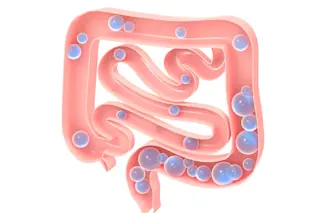Oooh! That Hook Hurts
“The fascination of shooting as a sport,” wrote P. G. Wodehouse, “depends almost wholly on whether you are at the right or wrong end of the gun.” New research suggests the same may be true of fishing rods.
Lynne Sneddon, a biologist at the University of Liverpool, and her colleagues at the Roslin Institute near Edinburgh, Scotland, injected the mouths of anesthetized rainbow trout with bee venom, acetic acid and, as a control, an innocuous saline solution. In the fish treated with venom and acid, Sneddon detected firing patterns from 22 different neurons that were “identical to those found in humans when they experience pain.” In a second, similar experiment, this time without anesthesia, the fish behaved as if they were in pain: They rocked from side to side, their breathing became more rapid, and they took much longer to resume feeding than the saline-injected fish. The trout treated with acid rubbed their mouths against the bottom and sides of the tank.
Some scientists remain skeptical. “Just because an organism responds to negative stimuli does not mean it’s conscious of pain,” argues James Rose, professor of zoology and physiology at the University of Wyoming. “Even avoidance-learning behaviors—where an animal learns to avoid noxious situations—can be unconscious.” He points out that fish lack a neocortex, the part of the brain that registers suffering and discomfort. “Pain is a psychological experience with an emotional dimension for which fish are unequipped.”
Sneddon says pain isn’t a complex emotion, just “a motivational state much like hunger, thirst, and fear. It causes animals to cope with a negative experience and impairs normal behavior. While I doubt any animal experiences pain the way humans do, if suffering and discomfort are indicated in their behavior, it is no less important biologically or ethically.” Rose says that fish behavior might be no more conscious than that of a coma patient who grimaces or cries out. Nonetheless, he agrees that “whether fish experience pain or not should not diminish our concern for their welfare.”
—Annette Foglino
Dieting Mothers May Have Premature Babies
A serendipitous discovery by physiologist Frank Bloomfield at the University of Auckland in New Zealand may explain almost half of all premature births.
In an attempt to tease out the effects of malnutrition on fetal growth rates, Bloomfield and his colleagues put one group of sheep on a diet designed to reduce their body weight by 15 percent. The diet started two months before pregnancy and continued for a month afterward. He allowed another group to eat to their heart’s content.
The calorie deficit had little effect on the birth weight of their offspring, but the dieting ewes gave birth about a week early—significant in an animal whose full term is about 21 weeks.
Moderate undernourishment of the mother at the time of conception triggered faster-than-normal development of the fetus’s pituitary and adrenal glands. That in turn led to elevated fetal levels of hormones, including cortisol, which is known to spike just before birth.
Bloomfield says that because there is no physiological reason women should react differently than ewes, proper nutrition close to conception—before a women even knows she’s pregnant—may be the key to preventing many premature births.
—Eric Levin
The Lobster’s Compass
Caribbean spiny lobsters live in reefs during the day and venture out for food at night. Until this year, however, no one understood how they find their way home in total darkness. Biologists Kenneth
Lohmann and Larry Boles at the University of North Carolina discovered that the spiny lobster Panulirus argus, an invertebrate not celebrated for brainpower, relies on an internal magnetic compass.
Like some migratory birds and sea turtles, spiny lobsters possess an ability known as true navigation, the ability to determine one’s position relative to a destination without reference to landmarks or cues gathered en route. To test how the spiny lobsters knew where they were situated, Lohmann and Boles caught about 100 lobsters in the waters off the Florida Keys, covered their eyes with rubber caps (see photo), placed them in plastic boxes full of seawater, loaded them on boats, and ran the boats in circles. Then they took them to an unfamiliar location that was seven to 23 miles away. When released, the lobsters were still able to creep back home, even though they had been deprived of all visual, chemical, or inertial clues.
“They can maintain a compass heading,” Lohmann says. Few other animals are known to show that characteristic, none of them invertebrates.
To determine more precisely how the lobsters are able to navigate, Lohmann and Boles exposed lobsters to magnetic fields that replicated those at specific locations around their home waters. When the lobsters experienced a field similar to one located north of their home area, they headed south. When they experienced a field similar to one south of their home area, they went north. The researchers say they were astounded by this ability to navigate magnetically. They think the skill may be related to small particles of magnetite, an iron oxide, located in two masses of nerve tissue in the forward part of the lobsters’ bodies.
—Michael W. Robbins
Songbirds Use More Energy at Rest Than Aloft
If you ever walked to a bus stop in winter and felt toasty until you stood awhile waiting for the bus to come, you can sympathize with the migrating thrush. Weighing just an ounce each, the Swainson’s thrush and the hermit thrush migrate each spring from Central and South America to Canada. During the journey to colder climes, the tiny songbirds fly all night and log an average of 165 miles before stopping to rest for a day or two. How do they keep it up? In June a study of two annual migrations revealed that the flying part is relatively easy—the thrushes use half as much energy as they use to keep warm during stopovers.
A team led by Martin Wikelski of Princeton University intercepted the birds at a stopover habitat in Illinois. Each thrush was weighed, equipped with a radio transmitter, and given an injection of water containing two stable isotopes. Released, the birds were tracked for 24 hours, caught, and weighed again. Then a blood sample was taken. The degree to which the isotopes had been diluted served to quantify the creatures’ metabolic activity.
Each thrush maintained about the same body weight and fat content, but the birds that had rested that day expended nearly as much energy as those that had continued their migration. Over the entire migration, the team projected, the thrushes expended only 29 percent of their energy while airborne. “It turns out that keeping warm is a very expensive activity for these birds, and flying is a relatively cheap activity,” says Ronald Larkin, a wildlife ecologist at the Illinois Natural History Survey and a member of the research team.
—Michael W. Robbins
Monarch Butterflies Bounce Back From Winter Disaster
Monarch butterflies recovered this year from a freakish winter storm that wiped out roughly 500 million of them in Mexico in January 2002. The black-and-gold lepidopterans had just completed their annual migration from Canada and the eastern United States when the storm hit, pelting them with rain and snow and carpeting the ground with their frozen carcasses. Fortunately, last year’s migration was unusually large to begin with—the population varies each year depending on many environmental factors—and enough survived to breed what scientists hope will be an average-size migration of 3 billion in 2003.
That was only one of the monarchs’ many problems. Lincoln Brower, a biology professor at Sweet Briar College in Virginia, says outlaw logging in the monarchs’ wintering grounds cut out nearly half their habitat since scientists had found it in the mid-1970s. At the same time their migration is getting tougher. Widespread herbicide use in Texas and the Midwest is eliminating milkweed, a staple food during their journey each spring and fall. Extinction is not imminent, but Brower worries about another severe storm hitting Mexico in a year when the population has become smaller for other reasons. “It may just be a matter of time before we lose this migratory phenomenon,” he says.
—Michael W. Robbins














